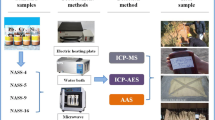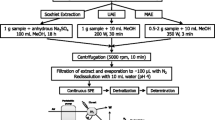Abstract
In this study, a new sample preparation strategy termed ultrasonic-assisted dispersive magnetic ionic liquid/magnetic solid wire microextraction (UA-DMIL/MSW-ME) has been developed for simultaneous determination of fifteen nitrotoluene compounds (NTCs) in the soil and water samples. The extraction was performed by dispersing a magnetic ionic liquid (MIL) into the sample solution using ultrasonic irradiation. After completing the extraction, by stopping the sonication, a neodymium wire (NW) was placed inside the sample solution allowing the MIL containing the pre-concentrated analytes to cover the surface of NW with a thin layer due to the magnetic forces. Afterward, the MIL-coated NW was subjected to a homemade syringe and directly injected into a gas chromatography–mass spectrometry (GC–MS) instrument for thermal desorption of analytes; then, quantitative measurements were taken. The central composite design was applied to explore some parameters influencing the extraction efficiency. Ultimately, under the optimized conditions, the proposed method was successfully implemented to analyze NTCs in the real samples (coastal and forestal soils, river water, and industrial wastewater) and acceptable results were obtained. The resultant calibration curves were linear over the concentration range of 0.07–80 μg/L (R2 > 0.993). The estimated limits of detection and quantification were lower than 0.07 μg/L, and the enrichment factors were between 3538 and 3817. The wire-to-wire and single-wire reproducibility values were found to be lower than 5.8% (n = 6). The intra- and inter-day repeatability varied below 5.5% (n = 6), and the relative recoveries were calculated between 91–110 and 89–108% for soil and water samples, respectively.




Similar content being viewed by others
Data availability statement
All data generated or analyzed during this study are included in this published article and its supplementary information files.
References
Babaee S, Beiraghi A (2010) Micellar extraction and high performance liquid chromatography-ultra violet determination of some explosives in water samples. Anal Chim Acta 662:9–13. https://doi.org/10.1016/j.aca.2009.12.032
Benedé JL, Anderson JL, Chisvert A (2018) Trace determination of volatile polycyclic aromatic hydrocarbons in natural waters by magnetic ionic liquid-based stir bar dispersive liquid microextraction. Talanta 176:253–261. https://doi.org/10.1016/j.talanta.2017.07.091
Chisvert A, Benedé JL, Anderson JL, Pierson SA, Salvador A (2017) Introducing a new and rapid microextraction approach based on magnetic ionic liquids: stir bar dispersive liquid microextraction. Anal Chim Acta 983:130–140. https://doi.org/10.1016/j.aca.2017.06.024
Clark KD, Nacham O, Purslow JA, Pierson SA, Anderson JL (2016) Magnetic ionic liquids in analytical chemistry: a review. Anal Chim Acta 934:9–21. https://doi.org/10.1016/j.aca.2016.06.011
Cortada C, Vidal L, Canals A (2011) Determination of nitroaromatic explosives in water samples by direct ultrasound-assisted dispersive liquid–liquid microextraction followed by gas chromatography–mass spectrometry. Talanta 85:2546–2552. https://doi.org/10.1016/j.talanta.2011.08.011
Costa dos Reis L, Vidal L, Canals A (2017) Graphene oxide/Fe3O4 as sorbent for magnetic solid-phase extraction coupled with liquid chromatography to determine 2,4,6-trinitrotoluene in water samples. Anal Bioanal Chem 409:2665–2674. https://doi.org/10.1007/s00216-017-0211-3
Del Sesto RE, Corley C, Robertson A, Wilkes JS (2005) Tetraalkylphosphonium-based ionic liquids. J Organomet Chem 690:2536–2542. https://doi.org/10.1016/j.jorganchem.2004.09.060
Del Sesto RE et al (2008) Structure and magnetic behavior of transition metal based ionic liquids. Chem Commun. https://doi.org/10.1039/B711189D
Deng N, Li M, Zhao L, Lu C, de Rooy SL, Warner IM (2011) Highly efficient extraction of phenolic compounds by use of magnetic room temperature ionic liquids for environmental remediation. J Hazard Mater 192:1350–1357. https://doi.org/10.1016/j.jhazmat.2011.06.053
Ebrahimzadeh H, Yamini Y, Kamarei F, Shariati S (2007) Homogeneous liquid–liquid extraction of trace amounts of mononitrotoluenes from waste water samples. Anal Chim Acta 594:93–100. https://doi.org/10.1016/j.aca.2007.05.013
Ebrahimzadeh H, Yamini Y, Kamarei F (2009) Optimization of dispersive liquid–liquid microextraction combined with gas chromatography for the analysis of nitroaromatic compounds in water. Talanta 79:1472–1477. https://doi.org/10.1016/j.talanta.2009.06.022
Es’haghi Z, Mohtaji M, Hasanzade-Meidani M, Masrournia M (2010) The measurement of ecstasy in human hair by triple phase directly suspended droplet microextraction prior to HPLC-DAD analysis. J Chromatogr B 878:903–908. https://doi.org/10.1016/j.jchromb.2010.02.015
Es’haghi Z, Sorayaei H, Samadi F, Masrournia M, Bakherad Z (2011) Fabrication of a novel nanocomposite based on sol–gel process for hollow fiber-solid phase microextraction of aflatoxins: B1 and B2, in cereals combined with high performance liquid chromatography–diode array detection. J Chromatogr B 879:3034–3040. https://doi.org/10.1016/j.jchromb.2011.08.042
Farrokhzadeh S, Razmi H (2018) Use of chicken feet yellow membrane as a biosorbent in miniaturized solid phase extraction for determination of polycyclic aromatic hydrocarbons in several real samples. Microchem J 142:403–410. https://doi.org/10.1016/j.microc.2018.06.036
Fernández E, Vidal L, Iniesta J, Metters JP, Banks CE, Canals A (2014) Screen-printed electrode-based electrochemical detector coupled with in situ ionic-liquid-assisted dispersive liquid–liquid microextraction for determination of 2,4,6-trinitrotoluene. Anal Bioanal Chem 406:2197–2204. https://doi.org/10.1007/s00216-013-7415-y
Fernández P, Taboada V, Regenjo M, Morales L, Alvarez I, Carro AM, Lorenzo RA (2016) Optimization of ultrasound assisted dispersive liquid-liquid microextraction of six antidepressants in human plasma using experimental design. J Pharm Biomed Anal 124:189–197. https://doi.org/10.1016/j.jpba.2016.02.041
Fernández E, Vidal L, Canals A (2018) Hydrophilic magnetic ionic liquid for magnetic headspace single-drop microextraction of chlorobenzenes prior to thermal desorption-gas chromatography-mass spectrometry. Anal Bioanal Chem 410:4679–4687. https://doi.org/10.1007/s00216-017-0755-2
Gaurav D, Malik AK, Rai PK (2009) Development of a new SPME–HPLC–UV method for the analysis of nitro explosives on reverse phase amide column and application to analysis of aqueous samples. J Hazard Mater 172:1652–1658. https://doi.org/10.1016/j.jhazmat.2009.08.039
Guan W, Xu F, Liu W, Zhao J, Guan Y (2007) A new poly(phthalazine ether sulfone ketone)-coated fiber for solid-phase microextraction to determine nitroaromatic explosives in aqueous samples. J Chromatogr A 1147:59–65. https://doi.org/10.1016/j.chroma.2007.01.132
Guerra E, Lamas JP, Llompart M, Garcia-Jares C (2017) Determination of oxidative hair dyes using miniaturized extraction techniques and gas chromatography-tandem mass spectrometry. Microchem J 132:308–318. https://doi.org/10.1016/j.microc.2017.02.017
Hatami M, Karimnia E, Farhadi K (2013) Determination of salmeterol in dried blood spot using an ionic liquid based dispersive liquid–liquid microextraction coupled with HPLC. J Pharm Biomed Anal 85:283–287. https://doi.org/10.1016/j.jpba.2013.07.025
Krieger BM, Lee HY, Emge TJ, Wishart JF, Castner EW Jr (2010) Ionic liquids and solids with paramagnetic anions. Phys Chem Chem Phys 12:8919–8925. https://doi.org/10.1039/B920652N
Lasarte-Aragonés G, Lucena R, Cárdenas S, Valcárcel M (2011) Effervescence-assisted dispersive micro-solid phase extraction. J Chromatogr A 1218:9128–9134. https://doi.org/10.1016/j.chroma.2011.10.042
Lordel S, Chapuis-Hugon F, Eudes V, Pichon V (2010) Development of imprinted materials for the selective extraction of nitroaromatic explosives. J Chromatogr A 1217:6674–6680. https://doi.org/10.1016/j.chroma.2010.04.081
Lordel-Madeleine S, Eudes V, Pichon V (2013) Identification of the nitroaromatic explosives in post-blast samples by online solid phase extraction using molecularly imprinted silica sorbent coupled with reversed-phase chromatography. Anal Bioanal Chem 405:5237–5247. https://doi.org/10.1007/s00216-013-6921-2
Lu N, He X, Wang T, Liu S, Hou X (2018) Magnetic solid-phase extraction using MIL-101(Cr)-based composite combined with dispersive liquid-liquid microextraction based on solidification of a floating organic droplet for the determination of pyrethroids in environmental water and tea samples. Microchem J 137:449–455. https://doi.org/10.1016/j.microc.2017.12.009
Mallick B, Balke B, Felser C, Mudring AV (2008) Dysprosium room-temperature ionic liquids with strong luminescence and response to magnetic fields. Angew Chem Int Ed 47:7635–7638. https://doi.org/10.1002/anie.200802390
Mattarozzi M, Bianchi F, Bisceglie F, Careri M, Mangia A, Mori G, Gregori A (2011) Planar solid-phase microextraction-ion mobility spectrometry: a diethoxydiphenylsilane-based coating for the detection of explosives and explosive taggants. Anal Bioanal Chem 399:2741–2746. https://doi.org/10.1007/s00216-010-4472-3
Mohsen Y, Lahlou H, Sanchez J-B, Berger F, Bezverkhyy I, Weber G, Bellat J-P (2014) Development of a micro-analytical prototype for selective trace detection of orthonitrotoluene. Microchem J 114:48–52. https://doi.org/10.1016/j.microc.2013.12.001
Nazari N, Masrournia M, Es′ haghi Z, Bozorgmehr M (2016) Simultaneous extraction and preconcentration of aniline, phenol, and naphthalene using magnetite–graphene oxide composites before gas chromatography determination. J Sep Sci 39:3046–3053
Ranjbari E, Hadjmohammadi MR (2015) Optimization of magnetic stirring assisted dispersive liquid–liquid microextraction of rhodamine B and rhodamine 6G by response surface methodology: application in water samples, soft drink, and cosmetic products. Talanta 139:216–225. https://doi.org/10.1016/j.talanta.2015.02.051
Rapp-Wright H, McEneff G, Murphy B, Gamble S, Morgan R, Beardah M, Barron L (2017) Suspect screening and quantification of trace organic explosives in wastewater using solid phase extraction and liquid chromatography-high resolution accurate mass spectrometry. J Hazard Mater 329:11–21. https://doi.org/10.1016/j.jhazmat.2017.01.008
Reyes-Gallardo EM, Lasarte-Aragonés G, Lucena R, Cárdenas S, Valcárcel M (2013) Hybridization of commercial polymeric microparticles and magnetic nanoparticles for the dispersive micro-solid phase extraction of nitroaromatic hydrocarbons from water. J Chromatogr A 1271:50–55. https://doi.org/10.1016/j.chroma.2012.11.040
Roushani M, Shahdost-fard F (2018) A glassy carbon electrode with electrodeposited silver nanoparticles for aptamer based voltammetric determination of trinitrotoluene using riboflavin as a redox probe. Microchim Acta 185:558. https://doi.org/10.1007/s00604-018-3098-6
Safavi A, Ahmadi R, Ramezani AM (2018) Vortex-assisted liquid-liquid microextraction based on hydrophobic deep eutectic solvent for determination of malondialdehyde and formaldehyde by HPLC-UV approach. Microchem J 143:166–174. https://doi.org/10.1016/j.microc.2018.07.036
Santos E, Albo J, Irabien A (2014a) Magnetic ionic liquids: synthesis, properties and applications. RSC Adv 4:40008–40018. https://doi.org/10.1039/C4RA05156D
Santos E, Albo J, Rosatella A, Afonso CA, Irabien Á (2014b) Synthesis and characterization of magnetic ionic liquids (MILs) for CO2 separation. J Chem Technol Biotechnol 89:866–871. https://doi.org/10.1002/jctb.4323
Sarafraz-Yazdi A, Amiri A (2010) Liquid-phase microextraction. Trends Anal Chem 29:1–14. https://doi.org/10.1016/j.trac.2009.10.003
Şener H, Anilanmert B, Cengiz S (2017) A fast method for monitoring of organic explosives in soil: a gas temperature gradient approach in LC–APCI/MS/MS. Chem Pap 71:971–979. https://doi.org/10.1007/s11696-016-0042-2
Shahraki S, Ahmar H, Nejati-Yazdinejad M (2018) Electrochemical determination of nitrazepam by switchable solvent based liquid-liquid microextraction combined with differential pulse voltammetry. Microchem J 142:229–235. https://doi.org/10.1016/j.microc.2018.07.003
Sintra TE et al (2017) Ecotoxicological evaluation of magnetic ionic liquids. Ecotoxicol Environ Saf 143:315–321. https://doi.org/10.1016/j.ecoenv.2017.05.034
Sobhi HR, Kashtiaray A, Farahani H, Javaheri M, Ganjali MR (2010) Quantitation of mononitrotoluenes in aquatic environment using dispersive liquid–liquid microextraction followed by gas chromatography–flame ionization detection. J Hazard Mater 175:279–283. https://doi.org/10.1016/j.jhazmat.2009.09.161
Trujillo-Rodríguez MJ, Nacham O, Clark KD, Pino V, Anderson JL, Ayala JH, Afonso AM (2016) Magnetic ionic liquids as non-conventional extraction solvents for the determination of polycyclic aromatic hydrocarbons. Anal Chim Acta 934:106–113. https://doi.org/10.1016/j.aca.2016.06.014
Yamini Y, Safari M (2018) Modified magnetic nanoparticles with catechol as a selective sorbent for magnetic solid phase extraction of ultra-trace amounts of heavy metals in water and fruit samples followed by flow injection ICP-OES. Microchem J 143:503–511. https://doi.org/10.1016/j.microc.2018.08.018
Yang M et al (2016) Use of magnetic effervescent tablet-assisted ionic liquid dispersive liquid–liquid microextraction to extract fungicides from environmental waters with the aid of experimental design methodology. Anal Chim Acta 906:118–127. https://doi.org/10.1016/j.aca.2015.12.019
Zarei AR, Nedaei M, Ghorbanian SA (2017) Application of deep eutectic solvent based magnetic colloidal gel for dispersive solid phase extraction of ultra-trace amounts of some nitroaromatic compounds in water samples. J Mol Liq 246:58–65. https://doi.org/10.1016/j.molliq.2017.09.039
Zarei AR, Nedaei M, Ghorbanian SA (2018) Ferrofluid of magnetic clay and menthol based deep eutectic solvent: application in directly suspended droplet microextraction for enrichment of some emerging contaminant explosives in water and soil samples. J Chromatogr A 1553:32–42. https://doi.org/10.1016/j.chroma.2018.04.023
Zhang C, Ingram IC, Hantao LW, Anderson JL (2015) Identifying important structural features of ionic liquid stationary phases for the selective separation of nonpolar analytes by comprehensive two-dimensional gas chromatography. J Chromatogr A 1386:89–97. https://doi.org/10.1016/j.chroma.2015.01.074
Zhang W et al (2016) Tetraazacalix[2]arence[2]triazine coated Fe3O4/SiO2 magnetic nanoparticles for simultaneous dispersive solid phase extraction and determination of trace multitarget analytes. Anal Chem 88:10523–10532. https://doi.org/10.1021/acs.analchem.6b02583
Acknowledgement
The authors thank the Research Council of Islamic Azad University of Mashhad for providing the service of instrumental analysis and laboratory facilities. This research did not receive any specific grant from funding agencies in the public, commercial, or not-for-profit sectors.
Author information
Authors and Affiliations
Corresponding author
Ethics declarations
Conflict of interest
The authors confirm that there are no known conflicts of interest related to this publication, and this work has not received any significant financial support to influence its outcome.
Ethical approval
This article does not contain any studies with human participants or animals.
Informed consent
Informed consent is not applicable in this study.
Additional information
Publisher's Note
Springer Nature remains neutral with regard to jurisdictional claims in published maps and institutional affiliations.
Electronic supplementary material
Below is the link to the electronic supplementary material.
Rights and permissions
About this article
Cite this article
Ismailzadeh, A., Masrournia, M., Es’haghi, Z. et al. An environmentally friendly sample pre-treatment method based on magnetic ionic liquids for trace determination of nitrotoluene compounds in soil and water samples by gas chromatography–mass spectrometry using response surface methodology. Chem. Pap. 74, 2929–2943 (2020). https://doi.org/10.1007/s11696-020-01131-3
Received:
Accepted:
Published:
Issue Date:
DOI: https://doi.org/10.1007/s11696-020-01131-3




